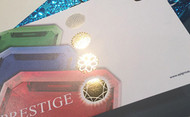What to look out for when hot foil stamping on different substrates
14th Jul 2021
July 14, 2021
WHAT TO LOOK OUT FOR WHEN HOT FOIL STAMPING ON DIFFERENT SUBSTRATES
Unlike standard printing techniques which relate to the reproduction of written, pictorial and ornamental images on paper, cardboard and similar materials, hot foil stamping is an application well outside this definition. All wettable materials, paper, board, thermoplastics, duroplastics, leather, textiles, wood and many other materials can be printed, stamped, coated, or refined with hot stamping foils and be finished to a specification.

|

|

|

|
These are among the least troublesome of print carriers and do not restrict the choice of stamping foil. With cast coated papers/boards, pressure and temperature activated adhesion of the surface very much benefits hot foil stamping. This adhesive action only has an undesirable effect in papers/boards coated both sides as it causes the printing sheet to stick to the packing. In such cases, it is best to use easy release stamping foils, which allow low stamping temperature, which will avoid activating the inherent adhesive effect of the material. The make-ready should be covered if it consists of a plastic material with a protective sheet.
Easy release stamping foils are more suitable for stamping solid areas since compression force applied to the cardboard coating can be reduced. High density cast-coated papers/boards can be pressure sensitive, therefore leading to poor results in stamping solid areas due to the formation of shadows and small blemishes.
Papers and Boards with Smooth or Rough Surfaces

|

|

|

|
Papers and Boards with Smooth or Rough Surfaces

|

|
Papers and boards with metallic plastic coatings, particularly involving the use of polyolefins such as polyethylene, accept stamping foil only with great difficulty. Papers/ boards that have been foil-laminated or specially coated with polypropylene, particularly with areas of solid print or similar decoration will require a significantly strong adhesion of the stamping foil.
The use of other surface coatings, will also limit the use of hot stamping foils. Since such print carriers tend to gas quickly, it is recommended that solid area foil stamping be carried out with rotary or cylinder stamping machines.
Generally the above limitations may not apply if the hot stamping artwork involves lettering, lines and small ornamental areas, as these can be generally done without trouble using any machine.
Also important to keep in mind is that subsequent damage from plasticisers can occur not only with soft PVC foils, but also with PVC coated self-adhesive papers (plasticiser resistant stamping foils).
Leather Fibrous Substrates And Soft PVC

|

|
Leather and other fibrous surfaces are normally less problematic printing materials. The fineness of the hot stamping that can be executed depends greatly on the grain of the surface. A rough surface or coarse grain refracts light, which can make fine lettering illegible (“filling”). It is important to remember that a good surface covering is extremely difficult to obtain on coarse-grained materials since the grain cannot be smoothly printed in the normal stamping procedure. Although very fine lettering can be produced with tighter release stamping foils, it should not be done below a certain limit.
Soft PVC can also be hot stamped without much difficulty with selected foils (e.g. MVP, GFE). With the normal stamping method, the same restrictions apply as in the case of leather, fibrous substances and grained, nitrocoated papers. For grained PVC materials embossing is by high-frequency stamping methods, in which the area is previously smoothed by high frequency embossing.
Creasing of Hot Stamped Impressions For Various Substrates
If a crease or fold extending over the hot stamping impression is to be made in the substrate, e.g. in the production of folding boxes, it is absolutely essential to check the “creasability” of the applied stamping foil in each case. It is not sufficient to test the creasing behaviour of the “cardboard or paper” base material.

|

|
All further finishings, such as offset printing, lacquering or foil lamination, affect the creasability of a material. The same comments also apply to the “hot stamping” finishing stage. We recommend that you check the creasability of the hot stamped impression and substrate, at the beginning and during the production run. An optical evaluation is not enough to ensure quality given the extreme stresses to which a surface is subjected during folding and creasing, and in the carton gluing machine after treatment. For this reason creasability must be supplemented by passing the specimen through a gluing machine. Hot stamping near an area which has to be later folded or creased must be subjected to the most thorough care and quality checks.
To download a copy of our infosheet for your reference, click the download button below.
We hope you have found this informational mailer helpful. If you have any futher queries or want to request a free foil sample swatch, please contact us below.



